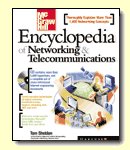|
Site home page
(news and notices)
Get alerts when Linktionary
is updated
Book updates and addendums

Get info about the Encyclopedia of Networking
and Telecommunicatons, 3rd edition (2001)

Download the electronic version of the Encyclopedia
of Networking, 2nd edition (1996). It's free!
Contribute to this site
Electronic licensing info
|
|
Gateway
Related Entries Web Links New/Updated Information
Note: Many topics at this site are reduced versions of the text in "The Encyclopedia of Networking and Telecommunications." Search results will not be as extensive as a search of the book's CD-ROM.
There are many types of gateways. One definition of a gateway is a computer system or other device that acts as a translator between two systems that do not use the same communication protocols, data-formatting structures, languages, and/or architecture. Unlike a bridge, which simply passes information between two systems without conversion, a gateway repackages information or changes its syntax to match the destination system. A gateway may also provide filtering and security functions, as in the case of a proxy server and/or firewalls. Note that most gateways operate at the application layer relative to the OSI protocol model, which is the topmost layer. Some examples of gateways are described in the following sections.
A router is a network layer gateway. In the early days of the Internet, routers were called "gateways." These devices provided links, initially between mainframe computers, and then later between LANs and other networks. The term "router" is more common now, but gateway is still used when configuring the IP protocol for host devices. Some networks have multiple routers that lead to other networks. A host can be configured so that one of the routers is selected over any of the others. It is usually called the "default gateway," meaning that it is the primary path to other networks. See "Routing." Other types of gateways are listed here.
- IBM Host Gateways
An IBM host gateway allows workstations attached to LANs to connect with IBM mainframe systems. See "IBM Host Connectivity" for more information.
- LAN Gateways
LAN gateways are used when joining networks that use different protocols, such as when a backbone network provides an interconnection for all the networks attached to it. For example, FDDI was a popular backbone networking technology used to interconnect many department and workgroup LANs. See "Backbone Networks" and "FDDI (Fiber Distributed Data Interface)."
- Electronic Mail Gateways
Electronic mail gateways translate messages from one vendor's messaging application to another's so that users with different e-mail applications can share messages over a network. A typical e-mail gateway converts messages to the X.400 format for electronic mail messaging or uses Internet mail. See "Electronic Mail."
- Firewall
A firewall is a device that allows internal network users to access the Internet while blocking Internet users from accessing the internal network. A full-featured firewall provides advanced screening, authentication, and proxy services to keep hackers and attackers from reaching vulnerable internal systems. See "Firewall."
- Proxy service
With a proxy service, the packet generated by an internal user never goes out over the Internet. Instead, the proxy service reads the packet and creates its own to send out over the network. Incoming packets are handled in the same way. They are never allowed through the proxy server as is. See "Proxy Servers."
- NAT (Network Address Translation)
An internal network may have its own internal IP addressing scheme that does not comply with the Internet addressing scheme or is hidden for security reasons. An NAT translates between internal and external IP addresses. See "NAT (Network Address Translation)."
- Caching services
A caching server may be part of a firewall and proxy server or a stand-alone device. It caches information that users have obtained from the Internet or external networks and keeps it available in case other users need that same information. See "Cache and Caching Techniques" and "Web Caching."
- Voice/Media Gateways
The term "convergence" is often used to describe the integration of voice networks (i.e., the telephone system) and data networks. The idea is to build one network that carries both voice and data. But voice is a streaming technology, while data is typically packetized. Media gateways, which are part of the softswitch architecture, provide an interface between the circuit-based PSTN and the packet-based Internet. See "Softswitch" and "Voice over IP (VoIP)" for more information.
- NAS (network access servers)
An NAS is a gateway into a larger network for dial-in users or ISDN users. It may also be classified as a RAS (remote access server). See "NAS (Network Access Server)" and "Remote Access."
Copyright (c) 2001 Tom Sheldon and Big Sur Multimedia.
All rights reserved under Pan American and International copyright conventions.

|

